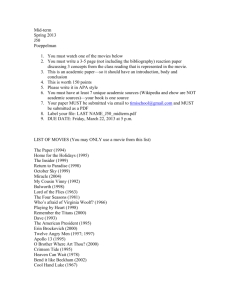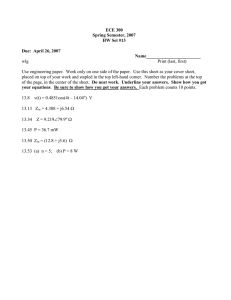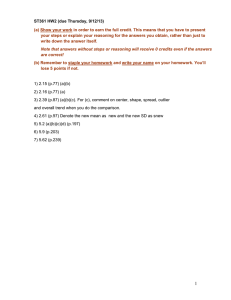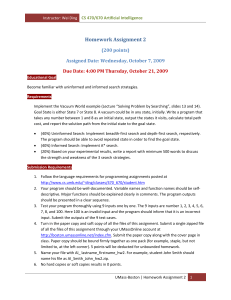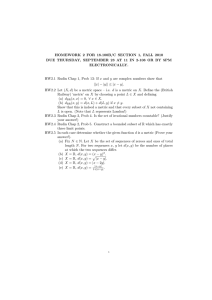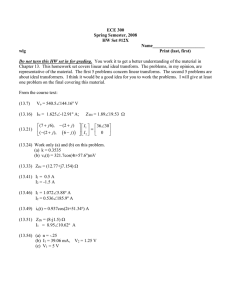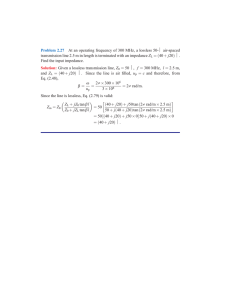EE324 HW2 Solution Fall 2012 Problem 1
advertisement
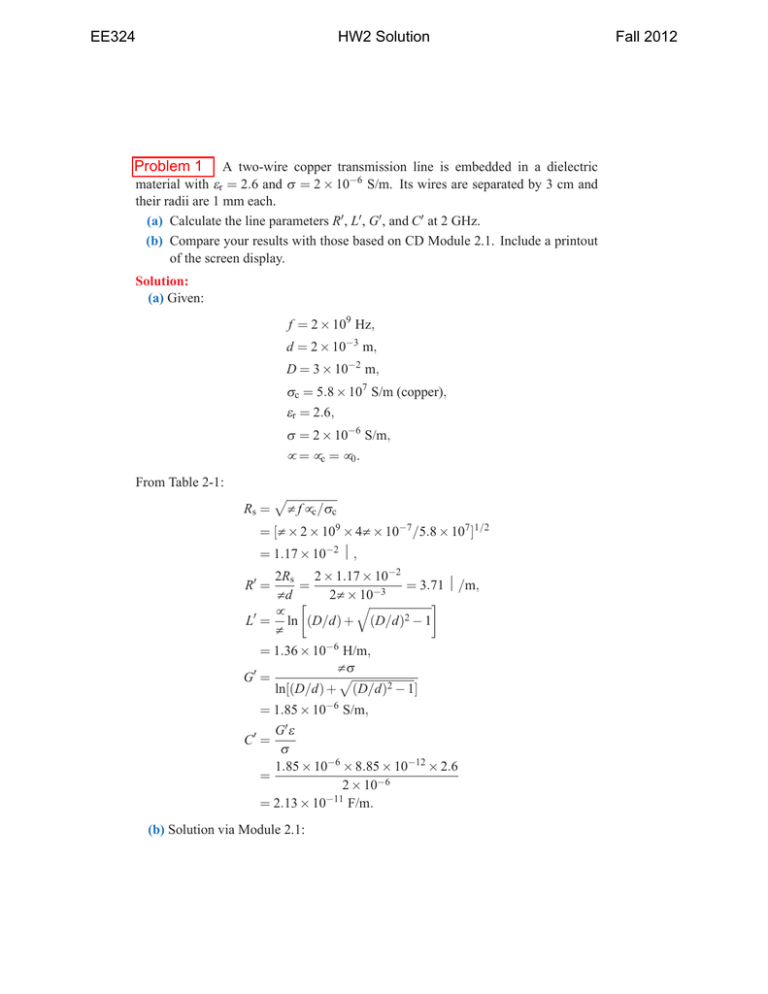
EE324 HW2 Solution Problem 1 A two-wire copper transmission line is embedded in a dielectric Problem 2.2 material with εr = 2.6 and σ = 2 × 10−6 S/m. Its wires are separated by 3 cm and their radii are 1 mm each. (a) Calculate the line parameters R′ , L′ , G′ , and C′ at 2 GHz. (b) Compare your results with those based on CD Module 2.1. Include a printout of the screen display. Solution: (a) Given: f = 2 × 109 Hz, d = 2 × 10−3 m, D = 3 × 10−2 m, σc = 5.8 × 107 S/m (copper), εr = 2.6, σ = 2 × 10−6 S/m, µ = µc = µ0 . From Table 2-1: Rs = p π f µc /σc = [π × 2 × 109 × 4π × 10−7 /5.8 × 107 ]1/2 = 1.17 × 10−2 Ω, 2Rs 2 × 1.17 × 10−2 = = 3.71 Ω/m, πd · 2π × 10−3 ¸ q µ ′ 2 L = ln (D/d) + (D/d) − 1 π R′ = = 1.36 × 10−6 H/m, πσ p G′ = ln[(D/d) + (D/d)2 − 1] = 1.85 × 10−6 S/m, G′ ε σ 1.85 × 10−6 × 8.85 × 10−12 × 2.6 = 2 × 10−6 −11 = 2.13 × 10 F/m. C′ = (b) Solution via Module 2.1: Fall 2012 EE324 HW2 Solution Fall 2012 EE324 HW2 Solution Problem 2 Find α , β , up , and Z0 for the coaxial line of Problem 2.6. Verify your Problem 2.8 results by applying CD Module 2.2. Include a printout of the screen display. Solution: From Eq. (2.22), p γ = (R′ + jω L′ )(G′ + jω C ′ ) q = (0.788 Ω/m) + j(2π × 109 s−1 )(139 × 10−9 H/m) q × (9.1 × 10−3 S/m) + j(2π × 109 s−1 )(362 × 10−12 F/m) = (109 × 10−3 + j44.5) m−1 . Thus, from Eqs. (2.25a) and (2.25b), α = 0.109 Np/m and β = 44.5 rad/m. From Eq. (2.29), s s R′ + j ω L ′ (0.788 Ω/m) + j(2π × 109 s−1 )(139 × 10−9 H/m) Z0 = = G′ + jω C ′ (9.1 × 10−3 S/m) + j(2π × 109 s−1 )(362 × 10−12 F/m) = (19.6 + j0.030) Ω. From Eq. (2.33), up = 2π × 109 ω = = 1.41 × 108 m/s. β 44.5 Fall 2012 EE324 HW2 Solution Fall 2012 EE324 HW2 Solution Fall 2012 Problem 3 Problem 2.18 Polyethylene with εr = 2.25 is used as the insulating material in a lossless coaxial line with characteristic impedance of 50 Ω. The radius of the inner conductor is 1.2 mm. (a) What is the radius of the outer conductor? (b) What is the phase velocity of the line? Solution: Given a lossless coaxial line, Z0 = 50 Ω, εr = 2.25, a = 1.2 mm: √ (a) From Table 2-2, Z0 = (60/ εr ) ln (b/a) which can be rearranged to give b = aeZ0 √ εr /60 = (1.2 mm)e50 √ 2.25/60 = 4.2 mm. (b) Also from Table 2-2, c 3 × 108 m/s up = √ = √ = 2.0 × 108 m/s. εr 2.25 EE324 HW2 Solution Problem2.19 4 Problem A 50-Ω lossless transmission line is terminated in a load with impedance ZL = (30 − j50) Ω. The wavelength is 8 cm. Find: (a) the reflection coefficient at the load, (b) the standing-wave ratio on the line, (c) the position of the voltage maximum nearest the load, (d) the position of the current maximum nearest the load. (e) Verify quantities in parts (a)–(d) using CD Module 2.4. Include a printout of the screen display. Solution: (a) From Eq. (2.59), Γ= ◦ ZL − Z0 (30 − j50) − 50 = = 0.57e− j79.8 . ZL + Z0 (30 − j50) + 50 (b) From Eq. (2.73), S= 1 + |Γ| 1 + 0.57 = = 3.65. 1 − |Γ| 1 − 0.57 (c) From Eq. (2.70) dmax = θr λ nλ −79.8◦ × 8 cm π rad n × 8 cm + = + 4π 2 4π 180◦ 2 = −0.89 cm + 4.0 cm = 3.11 cm. (d) A current maximum occurs at a voltage minimum, and from Eq. (2.72), dmin = dmax − λ /4 = 3.11 cm − 8 cm/4 = 1.11 cm. (e) The problem statement does not specify the frequency, so in Module 2.4 we need to select the combination of f and εr such that λ = 5 cm. With εr chosen as 1, f= 3 × 108 c = = 3.75 GHz. λ 8 × 10−2 The generator parameters are irrelevant to the problem. The results listed in the output screens are very close to those given in parts (a) through (d). Fall 2012 EE324 HW2 Solution Figure P2.19(a) Fall 2012 EE324 HW2 Solution Figure P2.19(b) Fall 2012 EE324 HW2 Solution Problem2.24 5 Problem A 50-Ω lossless line terminated in a purely resistive load has a voltage standing-wave ratio of 3. Find all possible values of ZL . Solution: S−1 3−1 = = 0.5. S+1 3+1 For a purely resistive load, θr = 0 or π . For θr = 0, ¸ · ¸ · 1+Γ 1 + 0.5 = 50 = 150 Ω. ZL = Z0 1−Γ 1 − 0.5 |Γ| = For θr = π , Γ = −0.5 and · ¸ 1 − 0.5 ZL = 50 = 15 Ω. 1 + 0.5 Fall 2012 EE324 HW2 Solution Problem2.27 6 At an operating frequency of 300 MHz, a lossless 50-Ω air-spaced Problem transmission line 2.5 m in length is terminated with an impedance ZL = (40 + j20) Ω. Find the input impedance. Solution: Given a lossless transmission line, Z0 = 50 Ω, f = 300 MHz, l = 2.5 m, and ZL = (40 + j20) Ω. Since the line is air filled, up = c and therefore, from Eq. (2.48), ω 2π × 300 × 106 β= = 2π rad/m. = up 3 × 108 Since the line is lossless, Eq. (2.79) is valid: ¶ · ¸ µ (40 + j20) + j50 tan (2π rad/m × 2.5 m) ZL + jZ0 tan β l = 50 Zin = Z0 Z0 + jZL tan β l 50 + j(40 + j20) tan (2π rad/m × 2.5 m) = 50 [(40 + j20) + j50 × 0] 50 + j(40 + j20) × 0 = (40 + j20) Ω. Fall 2012 EE324 HW2 Solution Problem2.28 7 Problem A lossless transmission line of electrical length l = 0.35λ is terminated in a load impedance as shown in Fig. P2.28. Find Γ, S, and Zin . Verify your results using CD Modules 2.4 or 2.5. Include a printout of the screen’s output display. l = 0.35λ Zin Z0 = 100 Ω ZL = (60 + j30) Ω Figure P2.28: Circuit for Problem 2.28. Solution: From Eq. (2.59), Γ= ◦ ZL − Z0 (60 + j30) − 100 = = 0.307e j132.5 . ZL + Z0 (60 + j30) + 100 From Eq. (2.73), S= 1 + |Γ| 1 + 0.307 = = 1.89. 1 − |Γ| 1 − 0.307 From Eq. (2.79) µ ¶ ZL + jZ0 tan β l Zin = Z0 Z0 + jZL tan β l " ¡ ¢# (60 + j30) + j100 tan 2πλrad 0.35λ ¡ ¢ = (64.8 − j38.3) Ω. = 100 100 + j(60 + j30) tan 2πλrad 0.35λ Fall 2012 EE324 HW2 Solution Fall 2012 EE324 HW2 Solution Fall 2012 Problem Problem2.32 8 A 6-m section of 150-Ω lossless line is driven by a source with vg (t) = 5 cos(8π × 107t − 30◦ ) (V) and Zg = 150 Ω. If the line, which has a relative permittivity εr = 2.25, is terminated in a load ZL = (150 − j50) Ω, determine: (a) λ on the line. (b) The reflection coefficient at the load. (c) The input impedance. (d) The input voltage Vei . (e) The time-domain input voltage vi (t). (f) Quantities in (a) to (d) using CD Modules 2.4 or 2.5. Solution: vg (t) = 5 cos(8π × 107t − 30◦ ) V, ◦ Veg = 5e− j30 V. 150 Ω I~ i Zg ~ Vg + Transmission line + + ~ Vi Zin Z0 = 150 Ω ~ VL ~ IL ZL (150-j50) Ω Generator - z = -l Zg ~ Vg + Load l=6m ~ Ii z=0 ⇓ + ~ Vi Zin Figure P2.32: Circuit for Problem 2.32. EE324 HW2 Solution Fall 2012 (a) c 3 × 108 up = √ = √ = 2 × 108 (m/s), εr 2.25 up 2π up 2π × 2 × 108 = λ= = = 5 m, f ω 8π × 107 ω 8π × 107 β= = 0.4π (rad/m), = up 2 × 108 β l = 0.4π × 6 = 2.4π (rad). Since this exceeds 2π (rad), we can subtract 2π , which leaves a remainder β l = 0.4π (rad). ◦ ZL − Z0 150 − j50 − 150 − j50 (b) Γ = = = = 0.16 e− j80.54 . ZL + Z0 150 − j50 + 150 300 − j50 (c) · ¸ ZL + jZ0 tan β l Zin = Z0 Z0 + jZL tan β l · ¸ (150 − j50) + j150 tan(0.4π ) = 150 = (115.70 + j27.42) Ω. 150 + j(150 − j50) tan(0.4π ) (d) ◦ Veg Zin 5e− j30 (115.7 + j27.42) e Vi = = Zg + Zin 150 + 115.7 + j27.42 µ ¶ − j30◦ 115.7 + j27.42 = 5e 265.7 + j27.42 ◦ ◦ = 5e− j30 × 0.44 e j7.44 = 2.2 e− j22.56 ◦ (V). (e) ◦ vi (t) = Re[Vei e jω t ] = Re[2.2 e− j22.56 e jω t ] = 2.2 cos(8π × 107t − 22.56◦ ) V. EE324 HW2 Solution Fall 2012
